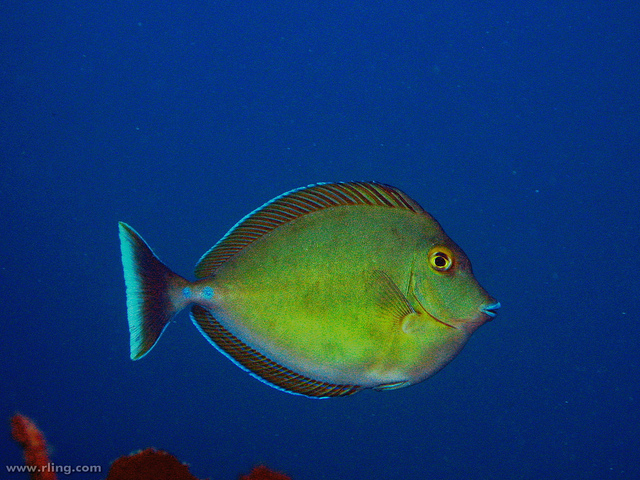�
�
�
���
Naso unicornis
Blue Spine Unicornfish
Kingdom
Animalia
Phylum
Chordata
Class
Actinopterygii
Order
Perciformes
Family
Acanthuridae
Genus
Naso
Species
Naso unicornis
Colours
Distinguishing features
A large olive grey fish with a short horn on the forehead, and a double pair of distinct blue spines at the tail base.
Size
- Up to 70 cm (Standard length)
Depth range
- Depth range data is not yet available.
Synonyms
Distribution
Distribution and habitat preferences
Areas of turf algae and coral rubble on reef flats and slopes, and lagoonal habitats.
Found in most reef locations around the island.
Behaviour
The Blue Spine Unicornfish is a roving herbivore, moving around the reef usually singly or in pairs, and feeding on large brown macroalgae. The surgeonfish are a very long lived group of fishes - after settlement to the reef, juveniles grow quickly and reach 80% of their maximum size in about 3 years, and then grow very slowly thereafter. Many of them live from 30-50years. They spawn in groups during the warmer months, when fast running tidal currents coincide with dawn and dusk.
Web resources
Danger
- unspecified - There are a pair of poisonous bony knives at the base of the tail, which can be used to inflict a painful stabbing wound if the fish is handled.
References
- Choat, J.H. and L.M. Axe (1996). Growth and longevity in acanthurid fishes; an analysis of otolith increments, Marine Ecology Progress Series, 134: 15-26. LIRS catalog number 460.
- Choat, J.H., K.D. Clements and W.D. Robbins (2002). The tropic status of herbivorous fishes on coral reefs. 1. Dietary analyses, Marine Biology, 140: 613-623. LIRS catalog number 729.
- Choat, J.H., K.D. Clements and W.D. Robbins (2004). The trophic status of herbivorous fishes on coral reefs 2: Food processing modes and trophodynamics, Marine Biology, 145: 445-454. LIRS catalog number 1202.
- View all references




